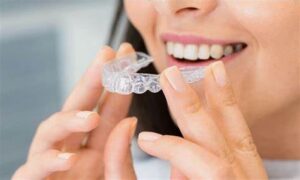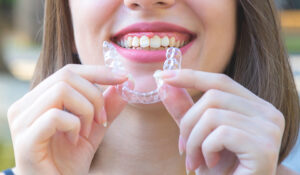Can Invisalign Help With Jawline Definition? The Hidden Aesthetic Benefits
Invisalign has quickly become one of the most popular options for straightening teeth, offering a discreet and comfortable alternative to traditional metal braces. Many people choose Invisalign not only for its convenience but also for the clear, nearly invisible appearance of the aligners. However, a common question that comes up is: Can Invisalign help define your jawline and subtly enhance the way your face looks?
The idea that teeth alignment could affect facial features might seem surprising, but the connection between your teeth, jaw, and overall appearance is stronger than you might think. At Smile Style NY, we’ve seen firsthand how properly aligned teeth can lead to not just a healthier bite but also improved facial balance.
In this article, we’ll explore how Invisalign works to shift your teeth and jaw, how those changes can influence your jawline and facial harmony, and what kinds of results you can realistically expect. We’ll also cover who is most likely to notice these improvements and how Invisalign compares to other orthodontic options.
How Invisalign Works: Shifting Teeth and Jaw Position

Invisalign uses a series of custom-made, clear aligners that apply gentle, controlled pressure to your teeth. Each aligner set is designed to make slight adjustments, gradually moving the teeth into better alignment over time. This steady movement doesn’t just straighten your smile—it also helps reposition the jaw to create a healthier and more balanced bite.
When teeth are misaligned, the jaw often shifts to compensate, which can cause strain and uneven facial structure. As Invisalign corrects tooth placement, it encourages the jaw to settle into a more natural, ideal position. This improvement can positively affect the lower face and jawline, creating subtle but noticeable changes.
It’s important to understand that Invisalign help extends beyond cosmetic benefits. The treatment improves both the function and the health of your mouth by aligning the bite, reducing stress on the jaw joints, and setting the foundation for a more harmonious facial appearance overall.
The Connection Between Jaw Alignment and Facial Appearance
Your teeth and jaw are the foundation for the lower third of your face. When the bite is misaligned, it can influence how the chin, jawline, and cheeks appear, even if the differences seem minor at first glance. A deep overbite can make the chin look less pronounced, while an underbite can create a jutting effect, making the lower jaw seem overly prominent.
Correcting bite issues helps bring the jaw into a more natural and balanced position. As Invisalign gradually shifts the teeth, the supporting structures of the face—such as the jaw joints and muscles—also adjust. This can lead to improvements in the way your jawline looks and how the overall lower face is proportioned.
By achieving a healthier bite, patients often experience a smoother, more harmonious facial structure. The changes might not be dramatic, but they contribute to a better balance between the upper and lower parts of the face, which plays a big role in both aesthetics and function.
How Invisalign May Enhance Jawline Definition
One of the lesser-known benefits of Invisalign is its ability to support better jawline definition by improving the alignment of your teeth and bite. While it’s best known for creating straighter smiles, Invisalign can also help subtly enhance the shape of the lower face by guiding the jaw into a more balanced position.
There are a few situations where these changes are more noticeable. For example, correcting a deep overbite can make the chin appear more prominent and well-defined. Patients with crowded teeth may find that as the jaw expands to accommodate proper alignment, the jawline looks broader and stronger. Even slight bite adjustments can sharpen facial angles and improve profile balance.
Although these changes are typically modest, they can have a real impact. By improving both function and symmetry, Invisalign help extend beyond a better smile—giving patients more confidence in the overall structure and appearance of their face.
Other Subtle Facial Improvements You Might Notice

In addition to enhancing jawline definition, Invisalign treatment can bring about other subtle but positive changes to your facial appearance. As your teeth and bite align properly, the underlying structure that supports your cheeks and lips shifts into a more natural position.
One noticeable difference some patients experience is fuller-looking cheeks. When crowding or misalignment is corrected, it can restore proper pressure and support to the mid-face area, giving the cheeks a slightly lifted, healthier appearance. Additionally, the alignment of the upper and lower teeth helps balance the lips, often making them look more even and harmonious when the mouth is closed.
Another common improvement is a smoother and more proportional side profile. With the jaw and teeth working together correctly, the transitions between the lips, chin, and jawline tend to appear more cohesive and natural.
While these changes are generally subtle, they can combine to create a fresher, more youthful look. Many patients report feeling more confident not only in their smile but in the overall balance of their facial features.
Who Is Most Likely to See Jawline Changes with Invisalign?
While Invisalign can support improvements in jawline definition, not every patient will notice a significant change. The results often depend on several individual factors.
Those with more severe misalignment or noticeable bite issues—like deep bites, underbites, or crossbites—are more likely to see visible changes in facial structure. Younger patients, especially teens whose bones are still developing, may also experience more pronounced shifts. In contrast, adults with milder cases typically see subtler improvements.
Keep in mind that the primary goal of Invisalign is to align teeth and improve bite function. Jawline definition is often a positive side effect, not a guaranteed result.
If you’re wondering what kind of outcome you might expect, consulting an experienced Orthodontist in Westchester County is the best first step. A professional evaluation can determine if Invisalign is likely to produce facial changes in your specific case.
How Invisalign Compares to Braces in Facial Changes
When it comes to facial changes, Invisalign and braces both work by adjusting the position of teeth and the jaw. However, the extent of these changes can vary depending on the treatment method. Invisalign generally produces more subtle adjustments, making it ideal for patients with mild to moderate alignment issues.
Braces, on the other hand, use brackets and wires to apply more direct and often stronger pressure, which can lead to more noticeable shifts in facial structure—especially in cases involving significant bite correction. This makes them a preferred option for patients with severe misalignment or jaw discrepancies.
If you’re weighing options like braces in Westchester County, it’s worth discussing with a local orthodontist how each treatment might impact your smile and facial features. While Invisalign offers a more discreet, gradual shift, traditional braces may be better suited for achieving more significant structural changes in severe cases.
What to Expect During Invisalign Treatment
The Invisalign treatment process is straightforward and designed for comfort and convenience. It begins with a consultation, where your orthodontist will assess your bite, take digital scans, and create a detailed treatment plan. From there, your custom aligners are created to fit snugly over your teeth and guide them into better alignment.
You’ll wear each set of aligners for 20 to 22 hours per day, only removing them for eating, drinking, brushing, and flossing. Every one to two weeks, you’ll switch to a new set of aligners, continuing the gradual adjustment. Regular check-ins with your orthodontist ensure your progress stays on track.
After treatment, you’ll likely need to wear a retainer—either full-time initially or just at night—to preserve your results, including any improvements in jawline definition.
If you’re considering Invisalign in Westchester County, finding an experienced provider who offers ongoing support and personalized care can make a big difference. Following the plan consistently—like wearing your aligners as directed—helps ensure you get the most out of your treatment, both in your smile and overall facial balance.
Conclusion: Subtle Changes, Stronger Confidence

Invisalign isn’t just about straightening teeth—it can also support small, positive changes in your jawline and facial structure. These improvements are usually subtle and depend on your unique alignment needs, but for many patients, the results go beyond a better smile.
Even minor adjustments in your bite and jaw position can lead to a more balanced, refreshed look. Improved facial harmony often boosts confidence in both social and professional settings.
If you’re wondering how Invisalign help with jawline definition and overall aesthetics, the team at Smile Style NY is here to guide you. Our experienced orthodontists can assess your smile, walk you through your options, and help determine if Invisalign is the right fit for your goals.
Start Your Invisalign Consultation with Smile Style NY
Want to find out if Invisalign can improve more than just your smile? Our team at Smile Style NY is here to answer your questions and guide you through every step. We’ll evaluate your bite, facial structure, and alignment to determine the best treatment approach for your goals. With years of experience and personalized care, we make the Invisalign process smooth and effective. Contact us today to schedule your consultation and take the first step toward a more confident smile.

